October 22, 2018 – Dayton, OH
When we were planning our trip south to Florida this year, we were originally going to take I-77 through the western Carolinas. With the sudden appearance of Hurricane Michael we decided that might not be wise, as Hurricane Florence had already soaked the area to its limit. Instead, we chose the old tried-and-true I-75 route that we used to take when we lived in Southeast Michigan. That route took us through Dayton, Ohio…and allowed me to fulfill a decades-old promise I had made with Diana.
Back in the 1990’s, the two of us traveled with my parents from Northwest Ohio to Dayton. Mom and Dad were living in Findlay at the time, and Dad wanted to take me to what was then called the Air Force Museum. With him being a World War II pilot and me being a certified airplane geek, it was pretty much a no-brainer. At the time, there was two large Quonset hut-style hangers housing the various aircraft, along with another hanger at the opposite side of Wright Field that held the Presidential aircraft. We worked our way through the huge exhibition space, taking a very long time in the WWII section. We exited the building and got in line for the bus across the field and BAM…they cut the line at the group directly in front of us. Last bus of the day, and we were on the wrong side of the cutoff. Diana was crushed, as the Air Force One display was the one thing she had her heart set on. I promised her that we would return someday, and that the Presidential planes would be our very first stop.
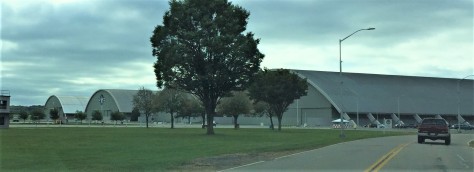
It took us twenty-some-odd years, but we made it! We pulled up to what is now called The National Museum of the U.S. Air Force to find two additional Quonsets beside the original pair. The entire collection is now in one location, meaning the bus ride across the base isn’t needed anymore. As was the case on our last visit, the museum admission was free of charge. 🙂 Once inside, we headed straight to the newest building, as that was where the Presidential planes were. As luck would have it, there was a guide who was about to start a tour of the entire hanger, so Diana thought we should join in.

Above is a panoramic photo of that space, a whopping 224,000 square feet! Over 70 aircraft and missiles are displayed in this area in four separate galleries: Space, Research & Development, Global Reach, and Presidential.

The Apollo 15 command module that orbited the moon is displayed here. This is the fifth moon capsule we’ve seen! (Apollo 11, 12, 14, 15 and 16)

They have a shuttle trainer that has a full-scale mock-up of the crew compartment. My thought looking at this is that the astronauts would have been flat on their backs during a launch. How did they get into those seats on the launch pad? Hmmmm….
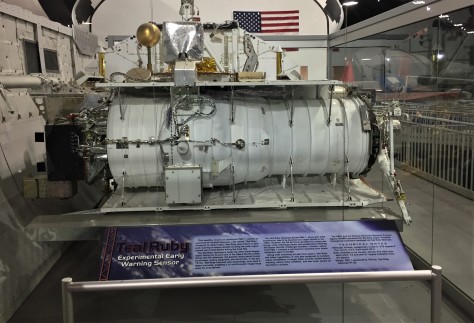
This satellite is called Teal Ruby. It was supposed to be an inexpensive spy satellite that could do a lot of things. Originally designed in the 1970’s, it’s ride on the shuttle kept getting pushed back. When Challenger exploded, it got bumped back to a point that it would likely not fly (for multiple reasons). During it’s development, this inexpensive little beauty saw it’s costs skyrocket (pun intended). We are looking at a $500 million museum piece, folks.

Above is the X-1B. Similar to the earlier X-1 ‘Glamorous Glennis’ that Chuck Yeager broke the speed of sound in, this aircraft was capable of flying over 1,600 miles per hour. For the record, that’s more than twice the speed of sound! Oh, and above it? That’s the right wing of a XB-70A. That plane is one of two experimental B-70 bombers built in the early 1960’s, capable of cruising at three times the speed of sound at 70,000 feet…far above Russian fighter capability at the time. The other plane crashed, leaving this as the only remaining example. Improvements in Russian surface-to-air missiles brought an end to the program.

In the Global Reach gallery, we were able to board the C-141C, better known as the Hanoi Taxi…the first plane to bring POW’s home from North Vietnam in 1973. At the time, it was a C-141. It was found that the planes would ‘bulk out’ before they ‘grossed out’…meaning they would be full well before their weight limit was reached. The Air Force stretched the entire fleet of 270 planes to utilize the extra cargo carrying capacity, renaming the modified planes C-141B. Near the end of the fleet’s career, 63 of the planes were modified with modern digital technology, thereby making them C-141C’s. Many of them…including this one…evacuated victims from Hurricane Katrina. 15 of these planes are on display at museums around the country, with the remaining aircraft having been scrapped.
On to the Presidential planes!
The museum has a wide variety of aircraft that were used by presidents, beginning with Franklin D. Roosevelt.
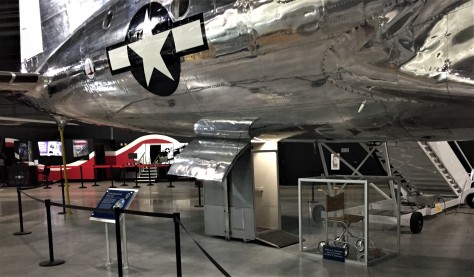
Roosevelt’s plane was called The Sacred Cow, due to its status. It was the only VC-54C ever built. Douglas Aircraft Co. installed this special elevator to help the wheelchair-bound president access the plane. He only used this plane one time, a trip to Yalta for the famous conference with Stalin and Churchill, two months prior to the president’s death. Harry Truman used it extensively for the first 27 months of his presidency. It is interesting to note that he signed the National Security Act of 1947 aboard this plane, which established the Air Force as a separate service. That makes The Sacred Cow the birthplace of the U.S. Air Force.
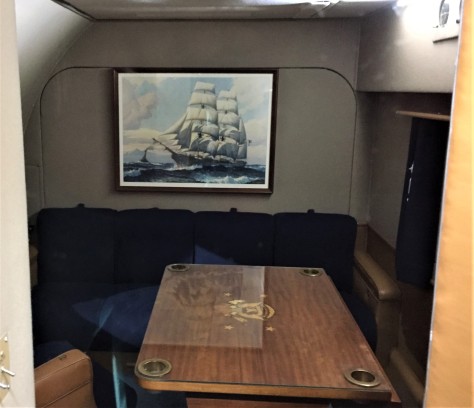
This was the small presidential conference room near the rear of the plane.

Truman followed with another Douglas aircraft named The Independence, after his hometown of Independence, Missouri. This was a modified DC-6.
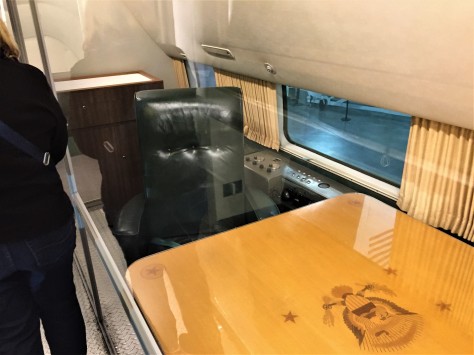
This is Truman’s chair in the small conference room in the middle of the aircraft. One thing to note: The aisles through all of these aircraft were glassed off and narrow. Not an easy place to be for folks who are claustrophobic.
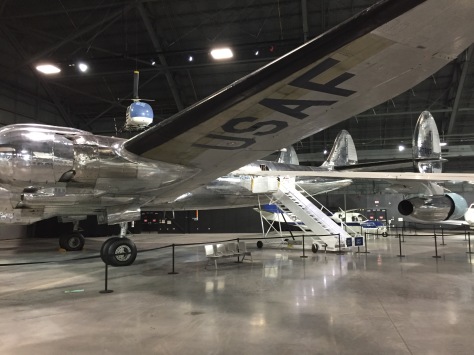
Next up was Dwight D. Eisenhower’s Columbine III. He had three Lockheed planes at his disposal over his eight years as president. This was a stylish aircraft, best known for its distinctive tri-tail. It was named for the state flower of Mamie Eisenhower’s adopted state of Colorado. She christened it with Colorado water, instead of the traditional bottle of champagne.
The most famous Presidential plane in the museum has to be the SAM 26000.
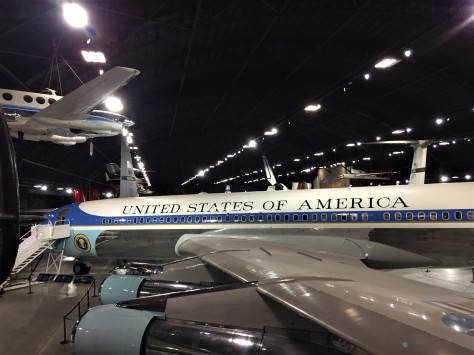
A modified Boeing 707, this was the first plane to sport the now-familiar paint scheme used on all of the Presidential planes. That look was created by industrial designer Raymond Loewy and First Lady Jacqueline Kennedy. This plane is best known for one fateful day: November 22, 1963. At 11:30 that morning, the jet delivered President Kennedy to Dallas Love Field. Less than three hours later, his body was brought back in a coffin to the plane after his assassination. 18 minutes after arrival, Lyndon Johnson was sworn in as President aboard the plane, with Lady Bird Johnson and Jackie Kennedy in her blood soaked skirt standing on each side of him. Nine minutes after that, the plane departed for Washington D.C.

To step aboard this aircraft is a humbling experience, to say the least. It is to be noted that the plane’s interior was reworked several times, so nothing resembles what we saw on that fateful day. The jet was used all the way into the Clinton presidency, finally retiring to the Air Force Museum in 1998, after 36 years of service.
A quick tour of other noteworthy planes in the museum:
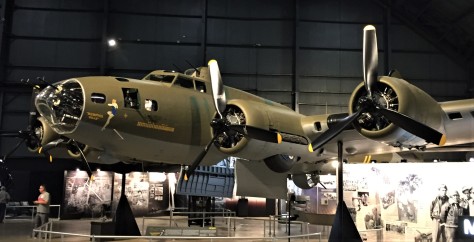
The famous B-17 bomber Memphis Belle, known for successfully completing 25 missions over Nazi occupied territory in WWII.
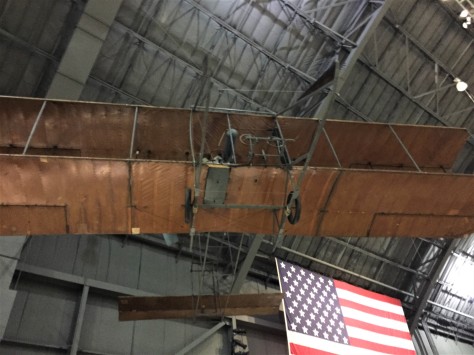
A Wright 3 Flyer, last modified in 1923.

The B-29 Superfortress Bockscar, known for dropping the atomic bomb on Nagasaki, Japan on August 9, 1945. That bombing is what brought about the end of World War II.
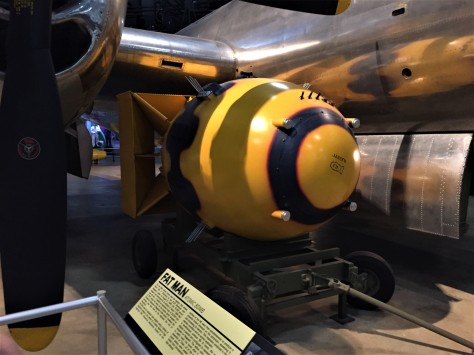
Again, humbling to see a Fat Man bomb that instantly wiped out so many people in that city.
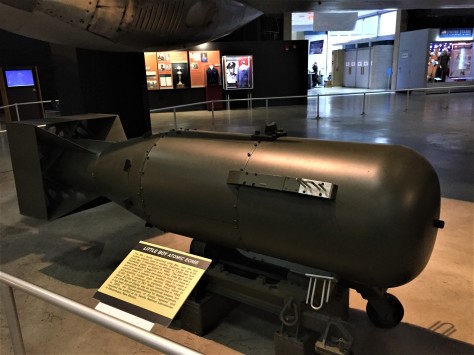
In the same display is a Little Boy bomb, the type used over Hiroshima. This was once an operational bomb.
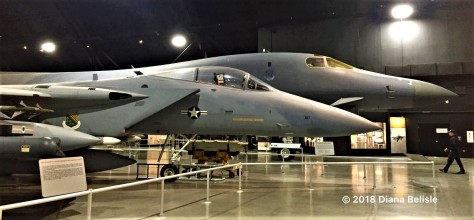
The smooth lines of a B-1B bomber, with an F-15 fighter in the foreground.

A B-2 Stealth bomber, able to fly undetected by radar.

An A-10 Warthog, with its massive engines that are needed to counteract the recoil from its rotary cannon at the front of the plane. Nothing worse than falling out of the sky by shooting your own gun!

A Stearman trainer, in the color scheme that would have been used on the planes my dad flew at Maxwell Field in Alabama.
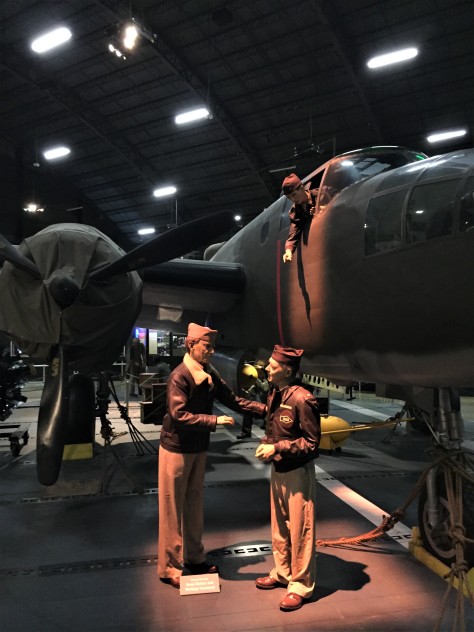
My dad also flew in B-25 bombers as a tail gunner and co-pilot. This display had to do with the Doolittle Tokyo raid, in which sixteen B-25’s, each with a crew of five, took off from the aircraft carrier USS Hornet and bombed Tokyo. The mission was more a psychological victory than anything else, as not much physical damage was inflicted upon Japan. The planes were unable to return to the Hornet, with fifteen of them crash landing in China. The other plane landed safely in Russia. All but three crewmen initially survived the mission.
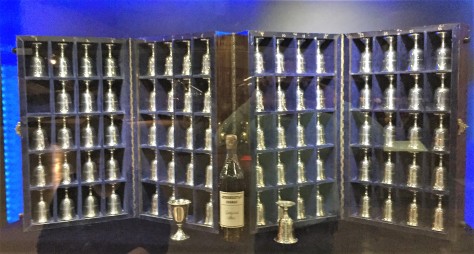
The Doolittle Raiders held a reunion from the 1940’s until 2013. Each year, the men would toast their fallen comrades with cognac in goblets inscribed with their names. The names were right side up on one side of the goblet, and upside down on the other. As each airman passed, their goblet was turned upside down in the case. Robert Hite was the last surviving raider, passing away in 2015.
It’s at this point that I wish to address accuracy when sharing history as a docent in a museum. Diana and I took our jobs at Heceta Head Lighthouse and at Sleeping Bear National Lakeshore very seriously, as to making sure the information we shared was correct. I’m not saying we are perfect, but our ultimate goal is to be accurate. I am purposely not sharing the photo I have of our tour guide at the Air Force museum. Story after story he told had an interesting twist. When he shared the urban legend “Good luck, Mr. Gorsky” as fact…and followed it up with “Verified by the family of Neil Armstrong”, the story begged for us to Google it. It’s a total whopper of a story, and it caused us to have to verify everything else he shared with us….most of which wasn’t completely true. If he is reading this, he knows who he is. History is amazing enough without making stuff up, my friend. It was a stain on an otherwise great visit.
By all means, if you can spare the time while in Dayton, be sure to visit the National Museum of the U.S. Air Force. In addition, there are several National Park sites that are part of the Dayton Aviation Heritage National Historical Park. Most, but not all, are associated with the Wright Brothers. It’s a fun place to explore!
Until next time, safe and happy travels to all!

Now that’s my kind of Museum!
LikeLiked by 1 person
It’s pretty darned amazing, Steve and Dianne! You could easily spend a couple of days going through it!
LikeLike
How fun to see all of this right after we saw the Wright Brothers Memorial – it’s amazing what’s been accomplished since then! Loved learning about the Sacred Cow.
LikeLiked by 1 person
It’s fun to dig into the stories behind each exhibit, Jodee. There’s a whole lot more there than just a bunch of airplanes!
LikeLike
Very interesting, glad that you made it there after 20 years! Safe travels to Florida, maybe our paths will cross down there this year.
LikeLiked by 1 person
Let us know when you are here, Jim. We would love to see you guys!
LikeLike
It’s an amazing place. Glad you got to see the Presidential planes up close and personal.
LikeLiked by 1 person
We sure enjoyed it, Bonnie!
LikeLike
Great information as always!
Glad you guys got to go back after the long wait.
Safe travels to you my friends.
LikeLiked by 1 person
Thanks, Rick! Yes, it was good to get back there. We couldn’t believe how much bigger it had gotten!
LikeLike
What a great museum! Hopefully they have other docents that don’t embellish their stories! Safe travels to Florida.
LikeLiked by 1 person
We did hear another docent giving what sounded like an excellent tour. I’m sure most are good…but this isn’t the first museum this has happened to us at. We are sticklers for factual facts. 🙂
LikeLike
Glad you finally had the opportunity to make a return trip. Better late than never they say:) Seeing the Presidential planes would have been great. John would have enjoyed the entire museum. It is amazing how many of these museum there are around the country. We have seen many of them!
LikeLiked by 1 person
Us too! We completely skipped the early aviation part. I’d love to see that again!
LikeLiked by 1 person
I find it amazing that such a massive display is free of charge. How wonderful for anyone who has an interest in aviation. Although perhaps a drawback would be staff who are a bit off on facts.
LikeLiked by 1 person
I feel the people who were originally involved with those airplanes would want the stories told correctly. It really does matter.
LikeLiked by 1 person
No matter how many Air museum we had been to, Steve never fails to go to one but somehow we skipped this one :). Twenty years is not that long now that you made it there finally! Steve would love this museum!
LikeLiked by 1 person
I’ll bet he would, MonaLiza! 😊
LikeLike
I visited the museum in 1976. Fond memories of it. Took lots of pictures also. Thanks for posting yours.
LikeLiked by 1 person
Thanks, Pierre!
LikeLike